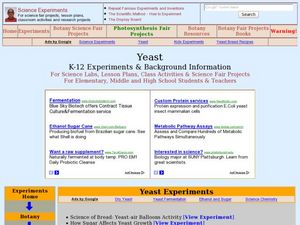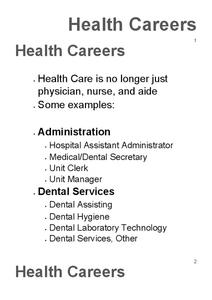Curated OER
Classification Number Two
A three-page quiz assessing budding biologists' understanding of classification. Middle-level learners may need a little additional time on this, but should be able to handle the concepts with ease.
Curated OER
The Sponges
In this sponge worksheet, students read about the different parts of a sponge and answer 20 short answer questions that follow. They color and label different sponge drawing.
Curated OER
The Classification of the Kingdoms of Life
Students can learn about the evolution of science by discussing the classification of living things.
Curated OER
Patterns of Heredity
Students describe the differences between incomplete dominance and codominant alleles, and between multiple alleles and polygenic inheritance. They describe how internal and external environments affect gene expression. They then...
Curated OER
Biology-Genetics
Students predict the probable mode of inheritance from a pedigree diagram showing phenotypes. They study the genetic basis for Mendel's laws of segregation and independent assortment. They give a Power Point slide show demonstrating the...
Curated OER
How To Make an Artificial Organ
High schoolers examine the advances made in technology with regard to prosthetics and replacement organs and limbs. They describe the anatomy and functions of different organs and create their own artificial organ. They defend and...
Curated OER
The Sense of Hearing
Students study the cycle of how we listen and hear our own speech. They examine sound waves, and the role of the nervous system in hearing. They investigate the cues besides lipreading that deaf people rely on for comprehension.
Curated OER
Bacteria: The good, the bad, the ugly
Seventh graders conduct an experiment. In this bacteria lesson, 7th graders list living and nonliving things and brainstorm the characteristics they share. Students are divided into two groups where they put samples of hand soap and...
Curated OER
Genetics and Heredity: The Next Generation
Tenth graders work in teams to order events of DNA transcription and translation protein synthesis. In the second lesson, they put the steps of mitosis and meiosis in order using a concept map poster. They use modeling clay to create...
Curated OER
Sea Urchin Embryology
Learners explore the process of evolution. They examine examples of how homeotic genes may work and obtain gametes. Using a microscope, students observe the fertilization of sea urchins. They video tape the process and write a...
Curated OER
Algae Part One: An Introduction
Young scholars have the opportunity to view two types of algae under 400x magnification with a compound microscope. They make observations and record their observations through drawings and words. In addition, they identify different...
Curated OER
What Is Life?
In this life characteristics worksheet, students answer 16 questions about living things, Redi's experiment, basic needs, growth and development.
Curated OER
Mutation and Genetic Change
In this genetic change worksheet, students read about how mutations can occur in germ cells and somatic cells. Students complete 1 multiple choice and 4 short answer questions.
Curated OER
Controlling the Code: Molecules at Word
Students investigate how cells determine which genes will be expressed and which will be silent. In this genetics lesson, students use on-line resources to complete a worksheet and gather information about gene regulation. Lesson...
Curated OER
Project Conclusion
In this cells activity students answer questions regarding the characteristics of living organisms observed during a pond water survey. Students draw diagrams of a food chain.
Curated OER
The Optimization of Food
Young scholars discuss nutrition and how to make better choices with food. In this algebra and nutrition instructional activity, students discuss the way the body process food and the importance of nutrition for our cells. They discuss...
Curated OER
Taxonomy Concept Map
Reinforce learners' knowledge of scientific taxonomy with a helpful concept map worksheet. Using a word bank, young biologists fill in the blanks to complete the description of organism classification.
Curated OER
What is Coral?
Students discuss what they know about coral reefs and are introduced to the importance of preserving coral reefs. In this coral reef lesson plan, students make connections between coral ecology in the classroom and in the real...
Curated OER
Sizing Up the Supersize Croc
Young scholars examine and compare traits of humans and crocodiles. In this crocodile lesson students use a ratio to estimate the height of a person and compare that to a crocodile.
Curated OER
Parental Genes
Eighth graders explore how different organisms pass their traits to their offspring. In this life science instructional activity, 8th graders differentiate recessive and dominant alleles. They predict the phenotype based on the genotype...
Curated OER
Yeast
Young scholars study the characteristics of yeasts. In this biology lesson, students conduct experiments to measure yeast respiration. They discuss the favorable conditions needed for growing them.
Curated OER
It's Just Right
Students conduct an experiment to determine the temperature tolerance of yeasts. For this biology lesson, students collect data and compare them by plotting graphs. They explain how extreme temperatures affect organisms.
Curated OER
Health Careers
Each of the 9 slides have a list of possible careers within areas of the Health industry. There are no explanations or details of any of the jobs and so this would be useful to introduce the areas and then let the students research some...
Curated OER
Apoptosis: Programmed Cell Death During Development
Students model the plasticity of neural pathways for memory in the brain. They simulate the cell activity according to dots on cards that they are given. They complete various simulations of different cell combinations.
Other popular searches
- Multicellular Organisms
- Multicellular Algae
- Unicellular Multicellular
- Unicellular and Multicellular
- Multicellular Life

























